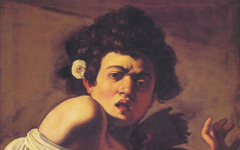Rubens’ Copy of Caravaggio’s Entombment (1612-14)
The imperative by which poetic painters make each work of art self-reflective is most evident in their copies after earlier masters. They often add their own identity to the earlier masterpiece in a way that even the casual art lover can find. Here's how.
Since the meaning they add must, almost by definition, be in the changes they make, play "spot the differences".1 When Rubens copied Caravaggio’s Entombment he added and removed figures but he also changed the hair color of the principal figures, including both Christ (the artist’s archetypal self) and Nicodemus (the biblical craftsman) in the foreground.
Click next thumbnail to continue
This is the original Rubens copied. Caravaggio whose real name was Michelangelo Merisi had originally given Nicodemus in the foreground the features of his namesake, the great Michelangelo.2 The "sculptor" then lowers his work of art, Christ, into his tomb. Christ's figure, as others have shown, is based on Christ in Raphael's Entombment which is itself based on Michelangelo's Christ in his Pieta. Thus Nicodemus "as Michelangelo" can be seen handling his own "work of art".
Click next thumbnail to continue
Rubens in changing the color of Nicodemus' hair to his own famously ginger tint demonstrated his own understanding of the Nicodemus-Michelangelo figure.
Rubens, though, also needed to express that 'every painter paints himself' as Caravaggio had done with Michelangelo and his reference to The Pieta. He thus changed Christ's beard to ginger too. Why artists identify with Christ is explained elsewhere, as is the importance of Nicodemus whose persona many artists had already adopted as their own including Michelangelo, Caravaggio, Raphael and Titian.
See conclusion below
On one level the casual or religious spectator can view either of these paintings as biblical narrative and thus an illustration of a Bible story. On a deeper level, the more insightful viewer sees “the artist with his self-reflecting masterpiece”, a fusion of studio life with the process of creation itself. It is a scene in the artist’s mind.
More Works by Caravaggio, Rubens
Notes:
1. Art historians tend to explain such changes as stylistic and thus meaningless. Here is an example about Rubens' copies after earlier masters: “Even a superficial comparison of originals and copies reveals that what Rubens adopts from his examples is not their ‘handling’; indeed, Rubens retains his own specific brushwork. What is of most interest to him is ordinanntie, the spatial choreography of the figures.” Of course he was interested in the composition. So are all good artists who copy masterpieces but that does not explain the meaning behind the changes which, in turn, is likely to impact the composition. Thijs Weststeijn, The Visible World: Samuel Van Hoogstraten’s Art Theory and the Legitimation of Painting in the Dutch Golden Age (Amsterdam University Press) 2008 p. 142
2. Walter Stechow, “Joseph of Arimathea or Nicodemus” in Studien zur toskanischen Kunst: Festschrift fur L.H. Heydenreich, ed. W. Lotz and L. Moller (Prestel-Verlag: Munich) 1964, p. 302; reprinted in Michelangelo: Selected Readings, ed. W.E.Wallace (New York and London: Garland Publishing) 1999, pp. 476; Corine Schlief, "Nicodemus and Sculptors: Self-reflexivity in Works by Adam Kraft and Tilman Riemenschneider", Art Bulletin 74, Dec. 1993, p.611
Original Publication Date on EPPH: 19 Apr 2010. | Updated: 0. © Simon Abrahams. Articles on this site are the copyright of Simon Abrahams. To use copyrighted material in print or other media for purposes beyond 'fair use', you must obtain permission from the copyright owner. Websites may link to this page without permission (please do) but may not reproduce the material on their own site without crediting Simon Abrahams and EPPH.






